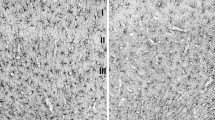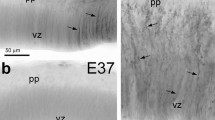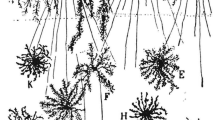Summary
The amphibian spinal cord is characterized by the presence of radially oriented astrocytic glial cells. These cells have their somata located in the grey matter of the spinal cord and radial processes that extend from the soma through the grey and white matters to the pial surface of the cord. Here we show that these radial glial cells are the predominant cell type labelled by horseradish peroxidase (HRP) when the marker is applied to the surface of the cord. The morphology of the HRP-labelled processes of an individual cell is different as they pass through the grey and white matter regions of the cord. By indirect immunofluorescence on frozen sections we show that the binding of an antibody raised against mammalian glial fibrillary acidic protein (GFAP) is preferentially localized in those areas of the glial process that traverse the white matter of the spinal cord. By transmission electron microscopy we confirm that there are no astrocyte cell bodies either at the pial surface or throughout the white matter region of the cord. These results demonstrate that all the astrocytes in the adult frog spinal cord can be selectively labelled through the application of HRP to the surface of the cord, and that the processes of these labelled cells display regional morphological and biochemical specializations depending on their location in the cord.
We propose that these astrocytes may play an important role in setting up the grey-white matter arrangement of the amphibian spinal cord and that a single astrocyte of the frog spinal cord may combine the properties and functions of both grey and white matter mammalian astrocytes.
Similar content being viewed by others
References
Adams, J. S. (1977) Technical consideration on the use of horseradish peroxidase as a neuronal marker.Ncuroscience 2, 141–5.
Bignami, A., Eng, L. F., Dahl, D. &Uyeda, C. T. (1972) Localization of the glial fibrillary acidic protein in astrocytes by immunofluorescence.Brain Research 43, 429–35.
Borges, L. F., Elliot, P. J., Gill, R., Iversen, S. D. &Iversen, L. L. (1985) Selective extraction of small and large molecules from the cerebrospinal fluid by Purkinje neurons,Science 228, 346–8.
Broadwell, R. D. &Brightman, M. W. (1979) Cytochemistry of undamaged neurones transporting exogenous protein in vivo.Journal of Comparative Neurology 185, 31–47.
Choi, B. H. (1981) Radial glia of the developing human fetal spinal cord: Golgi, immunohistochemical and electron microscopic study.Developmental Brain Research 1, 249–67.
Dahl, D. &Bignami, A. (1973) Immunochemical and immunofluorescence studies of the glial fibrillary acid protein in vertebrates.Brain Research 61, 279–93.
Eng, L. F., Vanderhaeghen, J. J., Bignami, A. &Gerstl, B. (1971) An acidic protein isolated from fibrous astrocytes.Brain Research 28, 351–4.
Eurich, F. W. (1898) Contributions to the comparative anatomy of the neuroglia.Journal of Anatomy and Physiology 32, 688–708.
Henrikson, C. K. &Vaughn, J. E. (1974) Fine structural relationships between neurites and radial glial processes in developing mouse spinal cord.Journal of Neurocytology 3, 659–75.
Kevetter, G. &Lasek, R. J. (1982) Development of the marginal zone in the rhombencephallon ofXenopus laevis.Developmental Brain Research 4, 195–208.
Liuzzi, F. J. &Lasek, R. J. (1985) Regeneration of lumbar dorsal root axons into the spinal cord of adult frogs (Rana pipiens), an HRP study.Journal of Comparative Neurology 232, 456–65.
Liuzzi, F. J. &Miller, R. H. (1985) Immunohistochemical characterization of normal and reactive glia in the adult frog spinal cord.Society for Neuroscience Abstracts 11, 396.
Ludwin, S. K., Kosek, J. C. &Eng, L. F. (1976) The topographic distribution of S-100 and GFA proteins in the adult brain: an immunohistochemical study using horseradish peroxidase labelled antibodies.Journal of Comparative Neurology 165, 197–208.
Michel, M. E. &Reier, P. J. (1979) Axonal-ependymal associations during early regeneration of the transected spinal cord inXenopus laevis tadpoles.Journal of Neurocytology 8, 529–48.
Miller, R. H. &Raff, M. C. (1984) Fibrous and protoplasmic astrocytes are biochemically and developmentally distinct.Journal of Neuroscience 4, 585–92.
Nieuwenhuys, R. (1964) Comparative anatomy of the spinal cord.Progress in Brain Research 11, 1–57.
Noble, M., Fok-Seang, J. &Cohen, J. (1984) Glia are a unique substrate for thein-vitro growth of central nervous system neurons.Journal of Neuroscience 4, 1892–903.
Nordlander, R. H. &Singer, M. (1982a) Oriented spaces precede axons inXenopus embryonic spinal cord.Experimental Neurology 75, 221–8.
Nordlander, R. H. &Singer, M. (1982b) Morphology and position of growth cones in the developingXenopus spinal cord.Developmental Brain Research 4, 181–93.
Peters, A. &Palay, S. L. (1965) An electron microscope study of the distribution and patterns of astroglial processes in the central nervous system.Journal of Anatomy 99, 419 (Ab).
Peters, A., Palay, S. L. &Webster, H. deF. (1976)The Fine Structure of the Nervous System: The Neurons and Supporting Cells, pp. 233–48. Philadelphia: W. B. Saunders.
Pruss, R. (1979) Thy-1 antigen on astrocytes in long term cultures of rat central nervous system.Nature 208, 688–90.
Raff, M. C., Fields, K. L., Hakomori, S., Mirsky, R., Pruss, R. &Winter, J. (1979) Cell-type-specific markers for studying neurones and the major classes of glial cells in culture.Brain Research 174, 283–308.
Rakic, P. (1971) Neuron-glia relationship during granule cell migration in developing cerebellar cortex. A Golgi and electronmicroscopic study in Maccacus rhesus.Journal of Comparative Neurology 141, 283–312.
Reier, P. J., Tabira, T. &Webster, H. DeF. (1976) The penetration of fluorescein-conjugated and electrondense proteins intoXenopus tadpole optic nerves following perineural injection.Brain Research 102, 229–44.
Sasaki, H. &Mannen, H. (1981) Morphological analysis of astrocytes in the Bullfrog (Rana catesbeiana) spinal cord with special reference to the site attachment of their processes.Journal of Comparative Neurology 198, 13–35.
Schachner, M., Hedley-Whyte, E. T., Hsu, D. W., Schoonmaker, G. &Bignami, A. (1977) Ultrastructural localization of glial fibrillary acidic protein in mouse cerebellum by immunoperoxidase labelling.Journal of Cell Biology 75, 67–73.
Schmechel, D. E. &Rakic, P. (1979) A Golgi study of radial glial cells in developing monkey telencephalon: morphogenesis and transformation into astrocytes.Anatomy and Embryology 156, 115–52.
Silver, J., Lorenz, S. E., Wahlsten, D. &Coughlin, J. (1982) Axonal guidance during the development of the great cerebral commissures: descriptive and experimental studies in vivo, on the role of preformed glial pathways.Journal of Comparative Neurology 210, 10–29.
Silver, J. &Sapiro, J. (1981) Axonal guidance during development of the optic nerve: the role of pigmented epithelia and other extrinsic factorsJournal of Comparative Neurology 202, 521–38.
Silver, J., Smith, G. M., Miller, R. H. &Levitt, P. R. (1985) The immature astrocyte: its role during normal CNS tract development and its ability to reduce scar formation and promote axonal regeneration when transplanted into thebrains of adults.Society for Neuroscience Abstracts 11, 334.
Singer, M., Nordlander, R. H. &Egar, M. (1979) Axonal guidance during embryogensis and regeneration in the spinal cord of the newt. The blueprint hypothesis of neuronal pathways patterning.Journal of Comparative Neurology 185, 1–22.
Stensaas, L. J. &Stensaas, S. S. (1968a) Astrocytic neuroglial cells, oligodendrocytes and microgliacytes in the spinal cord of the toad. 1. Light microscopy.Zeitschrift für Zellforschung 84, 473–89.
Stensaas, L. J. &Stensas, S. S. (1968b) Astrocytic neuroglial cells, oligodendrocytes and microgliacytes in the spinal cord of the toad. 2. Electron microscopy.Zeitschrift für Zellforschung 86, 184–213.
Varon, S. S. &Somjen, G. G. (1979) Neuron-glial interactions.Neurosciences Research Program Bulletin 17, 3–186.
Author information
Authors and Affiliations
Rights and permissions
About this article
Cite this article
Miller, R.H., Liuzzi, F.J. Regional specialization of the radial glial cells of the adult frog spinal cord. J Neurocytol 15, 187–196 (1986). https://doi.org/10.1007/BF01611655
Received:
Revised:
Accepted:
Issue Date:
DOI: https://doi.org/10.1007/BF01611655




